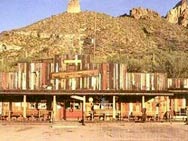Real Estate News for Wednesday, December 14th, 2005
 Why Buy a House When You Can Own a Whole Town? Sales of towns on Ebay attract media buzz, but few buyers. These three for-sale towns are forever joined in eBay notoriety with Langtry, Texas — former home of Judge Roy Bean — the dusty outposts of Amboy and Minkler, Calif.; historic Rocky Ford, Ga.; Monse, Wash.; and the ghost town of Palisade, Nev. Besides being offered for sale on eBay, what do these towns have in common? All are located in isolated rural areas; none has a population over a few hundred. "Fixer-upper" would be a generous way to describe the buildings still standing; in Bridgeville, several of the houses and buildings were deemed by the county to be uninhabitable. The towns are generally owned by older individuals or couples who are no longer interested in the expense and upkeep required to keep the towns operating. And none has what could be called a dominant industry or viable economic engine. There are exceptions: "The bad thing about a lot of them is, they don't generate any revenue — this one does," said David Levi, owner of Tortilla Flat. The town, originally a way station for water and horses, still retains some vitality because of its operating restaurant and shops. Click here to read more.
Why Buy a House When You Can Own a Whole Town? Sales of towns on Ebay attract media buzz, but few buyers. These three for-sale towns are forever joined in eBay notoriety with Langtry, Texas — former home of Judge Roy Bean — the dusty outposts of Amboy and Minkler, Calif.; historic Rocky Ford, Ga.; Monse, Wash.; and the ghost town of Palisade, Nev. Besides being offered for sale on eBay, what do these towns have in common? All are located in isolated rural areas; none has a population over a few hundred. "Fixer-upper" would be a generous way to describe the buildings still standing; in Bridgeville, several of the houses and buildings were deemed by the county to be uninhabitable. The towns are generally owned by older individuals or couples who are no longer interested in the expense and upkeep required to keep the towns operating. And none has what could be called a dominant industry or viable economic engine. There are exceptions: "The bad thing about a lot of them is, they don't generate any revenue — this one does," said David Levi, owner of Tortilla Flat. The town, originally a way station for water and horses, still retains some vitality because of its operating restaurant and shops. Click here to read more.
Brokers say rising mortgages may usher in era of 40-year loans. With predictions of 30-year, fixed-rate mortgages creeping up to 7 percent next year, mortgage and real-estate brokers say 40-year, fixed-rate loans could become commonplace as people try to get into a home. In its annual forecast, the California Association of Mortgage Brokers, based in Sacramento, projected that mortgage rates will reach an estimated average of nearly 7 percent for 30-year, fixed-rate mortgages and that 40-year, fixed-rate loans will become an important option for buyers. Click here to read more.
Tax trap threatens millions in 2006. House, Senate fail to forge AMT relief.
Efforts to slow the spread of the alternative minimum tax have bogged down in Congress, leaving more than 15 million taxpayers potentially susceptible to the ``stealth tax'' for the first time starting in 2006. Both the House and Senate have passed bills that provide another year of relief from the tax, which is particularly troublesome in affluent areas like Silicon Valley. But Senate Majority Leader Bill Frist, R-Tenn., told reporters Tuesday that wrangling over tax policy makes it unlikely Congress will push through narrow legislation addressing the AMT before the current patch expires Dec. 31. That means taxpayers will face roughly $30 billion in extra taxes under the AMT system unless lawmakers approve retroactive changes. Those taxes would be due April 15, 2007. Many taxpayers don't realize that they're supposed to calculate their income tax under both the regular rules and the AMT rules -- and then pay whichever bill is larger. The tax's reach is spreading into the middle class because every cut under the regular tax system forces more middle-class taxpayers instead to pay the AMT, which has never been indexed to inflation. Click here to read more.
~Tina Jan~
Coldwell Banker Kivett-Teeters
1655 E. Sixth St.
Beaumont, CA 92223
Work: 951-845-5520 Ext. 105
Fax: 951-845-4916
Cell: 909-446-2666
Toll-Free: 1-877-TINAJAN
tina.jan@coldwellbanker.com
www.tinajan.com

Comments
Post a Comment
Thank you for commenting!